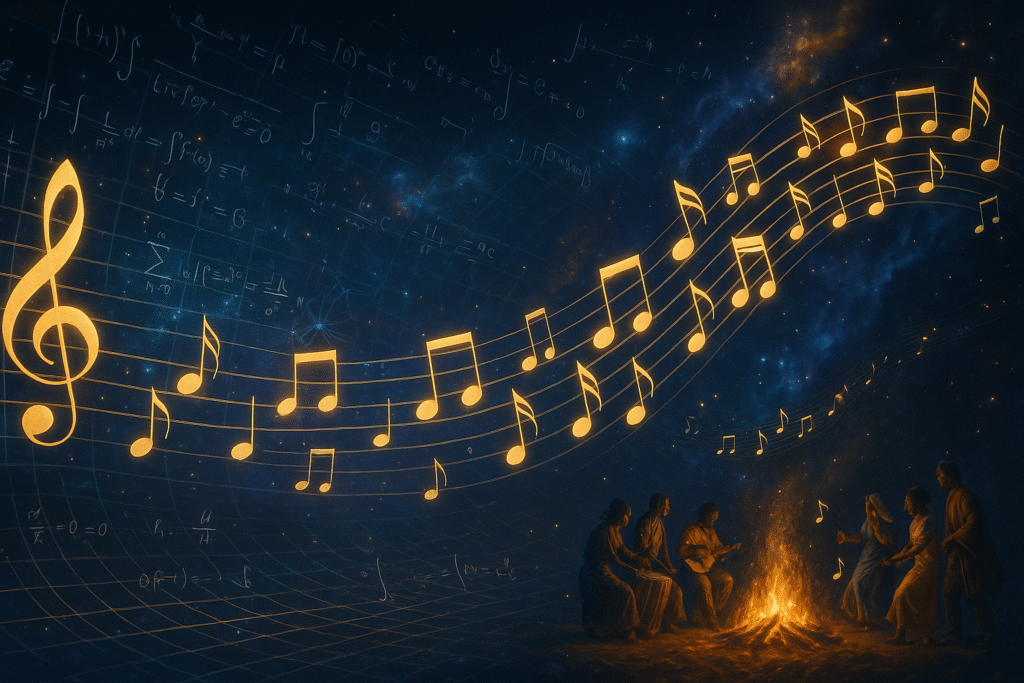

Its been our lives since we have been around!
We present a scientific argument that music points to intentional design.
This section briefly summarizes the core benefits and unique value of our products/services.
Music is almost universal in effect.
We all know this but most don’t know some of the mind blowing details.
The effects of music act like laws rather then effect.
The effects of music are already used when life and health count. The effects are so reliable that they appear to be a law rather then an effect.
We present a law / theory / predictions / experiments and falsification.
We went ahead and worked out an entire suite of scientific protocols for this argument.
The World Already Sings
Subtitle: Why the physics of instruments, the wiring of ears, and the pull of memory line up too neatly to be an accident.
Music isn’t sound with pretensions; it’s order you can feel. A single piano note is a non-linear drama: slightly stiff strings throw inharmonic partials and slow beats; two or three strings in unison chorus against each other; the bridge bleeds energy into a spruce soundboard that wakes a forest of modes; the room answers back. Your brain doesn’t see equations; it hears a person.
We didn’t have to get a universe where waves quantize into expressive structures, and bodies with ears that infer missing fundamentals and lock to meter, and minds that get paid in joy when long-range harmonic promises resolve. But that’s the universe we have. Cultures act like they know it. We crown moments with song because melody is memory with a steering wheel. A chorus can do what a thousand arguments can’t: make a “we.”
Naturalistic stories can cover the edges—alarm calls, bonding, sexual selection—but the stack feels overqualified. It supports counterpoint and polyrhythm, modulation and timbre painting, and still lands with an objective rightness for trained ears. A Mind-first reading compresses the surprise: perhaps the world is intelligible by design, our perception is tuned to that grammar, and the joy is a signature that contact has been made. You don’t have to sign a creed to notice the fit. You just have to listen.
1) Tuning systems are engineered—but the grammar keeps showing up
We’ve invented many tunings: Pythagorean, just, meantone, well temperaments, equal temperament. They carve the octave differently, but each yields an internal mathematics of relations. Give a listener a few seconds of context in any of these systems and they can hear a sour note or a cadence that lands short of home—even if they’ve never met that tuning before. The ear isn’t checking a universal pitch table; it’s learning a local grammar on the fly and policing violations. That’s the weird part: arbitrary tunings still generate non-arbitrary right/wrong within minutes. Freedom at the top, law at the bottom.
2) Degrees really do have “meaning”
Within a key, notes aren’t neutral. The leading tone begs upward; the dominant points home; the mediant paints the chord’s mood; altered degrees tilt emotion. Probe how listeners rate “fit” after a key context and you get a tonal hierarchy: some notes feel inevitable, others unstable. Harmony isn’t just stacking frequencies; it’s writing vectors of expectation in time. You can obey the scale and still “fail” musically by violating those vectors—proof that music’s logic outruns raw acoustics.
3) Emotion isn’t added later—it is the medium
Physics gives you spectra; cognition gives you prediction; music binds them into felt tension and release. A mistuned unison produces beating (a physical fact) that the brain hears as roughness (a percept), which composes into unease (an affect), which a composer can place at bar 63 to pay off at bar 64. That chain is not a metaphor; it’s the instrument. In most sciences, emotion is noise to be averaged out. In music, it’s a first-class variable—as objective, in its way, as meter.
A Mind-first explanation compresses the data
Music looks like designed resonance between three layers that didn’t have to line up—but do:
- Physics has deep musical structure. Solve the wave equation on a string, drum, or air column and you get discrete eigenmodes—small-integer ratios stacking partials. Fourier tells us any periodic sound decomposes into clean building blocks. This is math talking, not taste.
- Brains come pretooled to exploit that structure. The auditory system groups partials into a source, infers a missing fundamental, treats octaves as “the same,” separates simultaneity (harmony) from succession (melody), locks motor timing to meter, and pays dopamine when long-range predictions resolve.
- Humans are motivated to make culture out of it. Group synchrony builds trust, pain tolerance, and cohesion. We spend ridiculous time and energy on choirs, drums, rituals, studios—because it matters far beyond alarm calls.
Those layers could, in principle, have missed each other. We could live in a universe whose physics doesn’t quantize vibration into neat ratios; or in bodies with hearing tuned only to threat and speech; or with brains that find meter a nuisance. Instead, the math of waves, the biology of ears, and the psychology of meaning snap to grid. That’s not a gap; it’s a positive pattern.
A naturalist can reply: the ear learns whatever grammar you feed it; emotion is prediction error signed positive/negative; selection favored social glue. Yet the stack still overdelivers:
- Across wildly different tunings, a small dose of context produces shared judgments of fit, direction, and closure.
- The grammar scales to cathedral-level complexity (modulation, polyrhythm, extended harmony) yet remains teachable and shareable.
- The payoff is meaning-laden emotion that organizes memory and community (weddings, funerals, rallies)—not just arousal.
A Mind-first view compresses this: law-like structure in the world, law-seeking minds, and law-felt-as-value line up because they share a source. On that reading, tuning systems are human choices; musical rightness is a discovered alignment.
Keep us honest (tests that could fail)
- Carrier swap: Present patterns via audio, vibrotactile, and visual at safe SPLs. If entrainment and cadence-closure vanish without loudness, the claim is wrong.
- Blind tuning: Prime an unfamiliar tuning for 20–30 s. If probe-tone maps don’t show a hierarchy or off-note detection stays at chance, the claim is wrong.
- Timing of chills: If physiological peaks align with loudness/tempo alone rather than predicted resolutions, the claim is wrong.
- Group delta: If synchrony doesn’t move cooperation/pain tolerance vs. asynchrony, the claim is wrong.
If these hold—and a lot suggests they do—you’ve got something sturdier than rhetoric: regularities that behave like laws in the world–mind system.
So what?
If no one were here to hear, the emotional payload wouldn’t instantiate—just as “fragility” doesn’t exist without a force and a vase. That doesn’t make it fake. It makes it dispositional: when the world’s lawful structures meet the mind’s lawful receptors, Z happens. Regularly. Powerfully. On cue. Call it providence. Call it design. At minimum, call it what it looks like: not an accident.
Beethoven Coda (optional sidebar)
I remember the first time I heard Beethoven—the real Beethoven. It felt like someone sped up time. As a drummer training to go pro in heavy metal, I still wasn’t ready for how fast the music was flowing.I didn’t know humans could compose ideas for that type of speed let alone actually play it. To me it sounded like an alien. The fact that a human being can manipulate sound and a physical instrument on that level defies atheistic logic. How or why for all the sacred donkeys of Bakersfield would an animal be able to do such mind breaking feats with no purpose, meaning, or agency existing in the universe? The very ability alone to create one of his masterpieces makes a mockery of atheism and by contrast atheism makes a mockery of this giant. The premise and conclusions of atheism debase bravery, love, art, greatness, beauty and what it really means to be human and be alive. It begs us to ignore our entire inner voice because it demands there be …. well nothing. And nothing is all you get from an ideology like that. If atheism were true we would not see the good, bad, pathetic, awe inspiring expressions of human actions and capabilities. If there were no God there would never have been a Beethoven.

